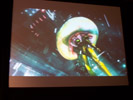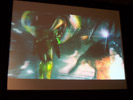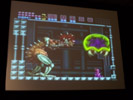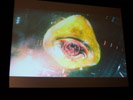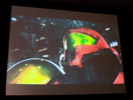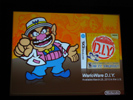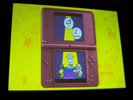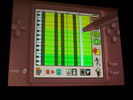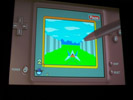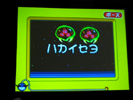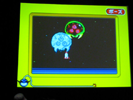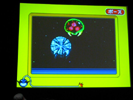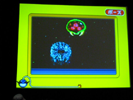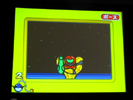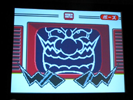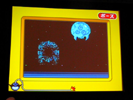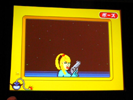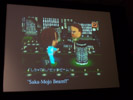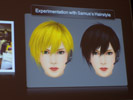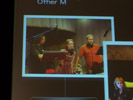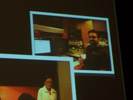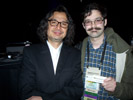Special articles, columns and features exclusive to the MDb.
Yoshio Sakamoto Lecture: From Metroid to Tomodachi Collection to WarioWare
by Capcom
03.11.10
At GDC 2010, I had the fortune to attend Yoshio Sakamoto's talk on his design philosophy. This text is more or less similar to what Yoshio Sakamoto said in his talk. It is missing statements in places where my translator failed and where I was unable to keep up with his pace of talking. So these are not entirely direct quotes. The complete version will be available for purchase through the GDC Vault, hopefully within a month or two. Most of the photographs within this feature were graciously donated by Aaron Kaluzka, owner of our host, Kontek.net and correspondent for Nintendo World Report. Thanks, Aaron!
From Metroid to Tomodachi Collection to WarioWare: Different Approaches for Different Audiences
After introducing himself to the audience, Mr. Sakamoto began his lecture with a recap of his work, stating, "I was virtually uninvolved in the games in the Prime series so nobody outside [Japan] knows [much about me]."
"I also work on subtle games [that are not major titles; that are niche titles.] In Japan, Metroid titles are known as niche titles as well, so I am known as making games with small appeal. I think this upsets the company, but I really like being in this kind of position."
"I will be speaking about what Satoru Iwata finds puzzling about my game style." Iwata wanted to know more about Mr. Sakamoto's puzzling game style - mainly, that he creates both very serious games (Metroid) and also very silly ones (Wario). However, to do so, he must first cover his history in game development.
Mr. Sakamoto's History of Game Development
First, Mr. Sakamoto introduces us to Metroid, beginning with Other M. In the previous Metroids (except 2, which he was not involved in), Mr. Sakamoto has been a director. But for Other M, he is the producer. Mr. Sakamoto is "hoping to make it the best Metroid ever." He then followed up with the trailer of the game from E3 2009. Mr. Sakamoto then went into more detail behind the history of the Metroid series.
First, Mr. Sakamoto is credited as a designer for the NES Metroid. "This was the dawn of videogames, so I hadn't had experience in design [at this point]." Though he was not involved with Metroid II, this was the game that determined what the rest of the series would be - particularly the scene where the baby appears: "If this story had not been created, the series would have taken a different path... Having been inspired [by the sequence], I took charge of Super Metroid."
In Super Metroid, Mr. Sakamoto chose to temporarily take control away from the player during certain cutscenes. "In doing this, the team was challenged [to tell a story without words]." This scene was recreated for Other M. Mr. Sakamoto then showed a video clip of the introductory cutscene from Other M, interspersed with images from the original Super Metroid version. This illustrated the narrative similarities, but it was also very striking to see the difference between the 1994 classic and the 2010 sequel.
"With Metroid Fusion for the GBA, I took the story and drama elements even further and lifted the ban of story development without words [I had placed on myself] with Super Metroid." He then reiterates that Other M appears chronologically between Super and Fusion. For Metroid Zero Mission, Mr. Sakamoto added a new scenario, in essence a new story – the Zero Suit sequence. Mr. Sakamoto served as directors on both Fuzion and Zero Mission.
Next, Mr. Sakamoto went into detail on the Wario Ware series. The series did not originate with his own creativity though (the original WarioWare was produced by Takehiro Izushi), but was the product of collaboration with other designers on the team.
"Let me introduce four titles I have worked on for the WW series" - Twisted, Touched, Smooth Moves, and DIY.
"Ware Ware Twisted came to be because one of my engineers was asked to test the tilt sensor and so created a minigame." Because it worked so well, it was given to Mr. Iwata. Iwata placed it on a twisty chair, which was spun like a record. Iwata thought it was so stupid and so Mr. Sakamoto knew it was a success. Twisted was the first WarioWare title he was a producer on. The photo below was produced to recreate what Mr. Iwata was thinking at the time.
Mr. Sakamoto took a new direction for Wario Ware Touched. In the beginning, he felt that understanding the WarioWare tone and what made it funny were not unified. "I worked with the new director in selecting new ideas and controlling the direction of the game."
WarioWare Smooth Moves was built as the flagship title for the Wiimote Controller and was released when it was launched. Like the DS version, it used motion as its primary element. There were problems with how the players could respond immediately to game commands, so the team implemented "graphic forms to indicate how players can play the game without taking them out [of the gameplay] for a moment." Because of this, WarioWare was a console game in which it was as much fun to watch other people as to play it yourself.
"The latest game in the set is WarioWare DIY. In this game, the player creates their own WarioWare Microgames. It came to be as a result of individuality of the designers who created it from the beginning. It challenges the player to be as goofy as they can be. Because players can share it with others, these creations can be polished and refined." If you want to hone the games you made [you can upload them to gain feedback].
Mr. Sakamoto then demonstrated his own Metroid-themed DIY game - which apparently "is supposed to be introduced in the US in some time in the future to maybe get people interested in the new Metroid." In this game, players must freeze Metroids by tapping them; the Metroids then fall down and shatter. If all Metroids are frozen, Samus appears in her power suit in a victory pose. If the player does so a second time, Zero Suit Samus appears.
Then Mr. Sakamoto talked about Tomodachi Collection - or Tomokore - which is about making gameplay a more subtle experience. "It is a little like playing house." It uses Wii characters and Mii characters. "Think of it as players having fun through make believe." The game was a surprise hit and has already hit the 3 million sales mark in Japan.
Mr. Sakamoto also wanted to talk about some unique games he had worked on, particularly the Famicom Tantei Club [Famicom Detective Club]. This game "defined my approach and style of game development from this point of my career forward." Famicom Tantei Club is a command-style text-based adventure, a horror-suspense game. "These were very important titles for me so I decided to in the end include them.
"There were many other titles I was involved in, but I don't want to take up time in introductions, so I will introduce one last title I made shortly after I started working on videogames." This game is Balloon Fight, which he was the designer on. None other than Mr. Satoru Iwata programmed the game. However, Mr. Sakamoto and Mr. Iwata had very different views of the game, which he recreates in this slide:
Mr. Sakamoto's Design Philosophy
"Where am I today? Why is it that someone like me is standing here [talking to you about games]? What is it that Mr. Iwata is wondering about? He was curious about my game development methods and this lead to the theme of my speech."
Mr. Iwata was interested in why "one person could work on a game with an intense story like Metroid Other M and then a funny game like WarioWare DIY. 'What is your strategy for creating games that are complete polar opposites?' Someone who has created such a dynamic range of titles should be important to listen to. So why don't you talk about that?'
"After hearing Mr. Iwata's suggestion, I felt highly perplexed: I hadn't thought about it [before]. The styles are different - people have said that many times. What was my approach as producer on these titles, and what does it mean in the first place? Having thought about this, I found it was hard to answer. For applying logic to intuitive actions, I decided to apply my own ideas to game creation."
Mr. Sakamoto has given names to each type of game. "I will call Metroid games serious and Wario games comical. Mr. Iwata finds it puzzling that I work on both. He finds it puzzling that I can create something with a serious touch as well. Mr. Iwata only thinks of me as someone with a comical touch."
Mr. Sakamoto gains his inspiration of game design from film that he came across in his youth, particularly Dario Argento, the Italian filmmaker who directed Suspira and Deep Red [Profondo Rosso]. "Without a doubt, Deep Red has had the greatest impression on my design." This film is a combination of suspense and horror. "Usually, there is something missing in suspense and horror films. Then I came across Argento's films. The style I had been looking for all along was there. I discovered that without a doubt, I wanted to create things in the same manner as Argento did. This is how I understood components of his technique.
Mr. Sakamoto then breaks down the basic components of Argento's films into mood, timing, foreshadowing, and contrast, elements he identifies as crucial to the "complete" horror movie. Mood includes music and sound. Argento's progressive rock sound gives a feeling of terror to his films. For timing, Argento effectively stopped the music in different scenes and used sound effects to change the mood. This music is an "almost indifferent echo of the stiff and robotic." He is "meticulous in using tricks" of foreshadowing to frighten his audiences. Finally, Argento contrasts storylines and scenes to increase the sense of tension within his films.
Having his youth influenced so much by Argento, Mr. Sakamoto designed Famicom Tantei Club. The student in the rear of the cover art is in homage to Argento's work. "This experience allowed me to gain confidence in my ability to produce a game."
"My latest project, Metroid Other M, is no exception. This technique of controlling mood, timing, foreshadowing, and contrast I have relied on in my career as a game designer from early on, and this is no different." Metroid: Other M shows "how deep my desire was to convey fear and how this lead me to find my own creative style. I was reminded of this fact in writing this speech. Having found my own sensibility and creative style, I want to pass that on to someone else."
"After seeing Argento's films, I started watching a lot of movies. I was looking for a variety of ways to control mood, timing, foreshadowing, and contrast. I watched many kinds of films. And I discovered lot of these elements are found in cult movies." As a result of watching these films, Mr. Sakamoto's "ability to daydream became stronger." He had dreams with background music and camera angles, etc. However, Mr. Sakamoto focused primarily on independent or cult films. "I wasn't drawn to big productions. This feeling is even stronger now." Further, he links this affinity for niche games his affinity for film.
Mr. Sakamoto was also influenced by the films of Luc Besson (Leon: The Professional). "[John Woo's films] for the A Better Tomorrow series had a particular effect on me. He has painful images coming from the Hong Kong movie scene." Mr. Sakamoto also picked Brian de Palma for the intense last scene in Carrie. I haven't seen all the movies [these directors] made. I don't see everything they make. I don't have a complex about it or strive to become one [of these filmmakers]. I was inspired by their films and that's how I was inspired to create games. They help bring that out in me. If I start talking [about them], I won't stop. This might be presumption, but the influence [from the films] is in the games."
Comedy
"Comedy - this influences me now. I love things that are funny and make me laugh. Is there a laugh here? Can I find something funny in this? I spend most of my day thinking about this. I ask if I can laugh, but I just want to make other people laugh myself. I'm not a comedian, so can't make a crowd of people go into an uproar. I just want to spice the lives of my coworkers and the people around me."
"I'm actually quite meticulous about it. I constantly work to hone my senses. When I find material I can use, I make sure to tuck it away for later. I take as much as possible to fit a wide range of audiences. I make it fit the style. I take the best material in my head and find the best situation to use it in. I want to control audience reaction and engineer a laugh.
"In addition, ultimately, the techniques used here are mood, timing, foreshadowing, and contrast. I take a read on what is normally there. That lull in the conversation [in a room packed with people] if you miss it, it's gone forever. I steer the conversation to set up the perfect one-liner. It's important to set a contrast."
Mr. Sakamoto's appreciation for comedy and the influence of movies has benefited his work on games with a serious touch and comical touch. "But these [types of games] are polar opposites – [Mr. Iwata wanted to know] do you have a stance when dealing with these two types?
"Whether serious or comical, I respond to things that stimulate my interest. I store this material away and wait for the opportune moment to bring it out. The methods and strategies which I employ are the same: I use control, mood, tense, foreshadowing, and contrast. The experience of thinking something is funny, cool, or scary is about having feelings moved. The method is the same and the process is the same regardless of the feeling." Essentially, comedy and horror are identical in that they are both about moving emotions, and these can be influenced by mood, tense, foreshadowing, and contrast.
"I must think about how those emotions are moved and how to set them. I must experience a wide range of moves within their own context. Experiencing this in the day to day life will naturally bring in a wide range of material to pull from. I think I just happen to be passionate about the serious and comical and two opposing types. I just happen to be fortunate to [be good at doing both]."
"To summarize: what is the difference in stance and approach when creating games that are polar opposite types?
"There is no difference. It's more about technique. As long as someone is open to the possibility of new experiences, you can use techniques that move people's hearts to move people in a great many ways.
"So in review, I'd like to talk about a game with a comic touch as well as the epic serious touch. Both games I produced, Tomodachi Collection and Metroid: Other M."
Tomodachi Collection
"Tomodachi Collection is impossible to explain in words, so I'll just show a video." Mr. The of Tomodachi Collection – also known as Tomokore - demonstrated of the game's Mii-like characters with Mr. Sakamoto, Mr. Iwata, and Reggie doing various things. In one case, Reggie is in a kimono, in another, Mr. Sakamoto is wearing a wedding dress, destroying a city as Godzilla, or running away from a giant boulder. What is most notable about these is that they are all reflections of his personal experiences, but can be shared with his friends.
In the most memorable sequence, Mr. Sakamoto tries to woo Samus. "I'm in love with Samus. I want to ask her out on a date, but..." Here are some images from Mr. Sakamoto's escapades – just check out that lounge lizard outfit!
Mr. Sakamoto then went on to discuss how the characters in Tomodachi Collection are similar to Mii's. They function a lot like Mii characters, but you can only put out the Mii parts. The development of the Mii's began with Mr. Sakamoto's team. Mr. Sakamoto disliked that he couldn't create a character that looked like himself. He wanted to know why he couldn't change the face parts. "I wanted to make something that looked more like I did." So he had the team change it. Mr. Iwata was very happy; the proto-Mii tool was a winner. In a few days, Iwata wanted to borrow the characters for the Wii. He also wanted to borrow the team that created them.
So Mr. Sakamoto built the Mii's and sent them to Shigeru Miyamoto upon Mr. Iwata's request. After the Mii editor was completed and the Mii characters were spreading around the world, the team came back. Based on what they knew and their experience, they developed Tomodachi Collection.
Tomodachi Collection faced many challenges in production. There had never been a game like it before, so they didn't know where they were supposed to land. Mr. Sakamoto was also busy on Other M at the time, so the director "must have been worried."
Mr. Sakamoto's role in Tomodachi Collection was producer: "Working with the director to stay true to the friend collecting image, making choices to stay true to the image of the game. I was very happy to have a wide variety of unusual and rare material from the archives to work with."
"So in this title, what examples can we find in mood, timing, and contrast?"
"In Tomokore, the story is driven by the player. Maybe some of you have already noticed, but the movie I showed earlier and the fact this is a common genre in the first place, Tomokore is a game where not only does the player have fun, but the player's friends have fun as well to show off the producer and comedy. With regard to this title, there are many more episodes I'd like to share with you, but I don't have time for them all.
A piece of advice he shares, he tells the director, "You need to take off your underwear." This means don't hold back, let yourself out. It has many different meanings.
Why am I bringing this hard to explain idea now? It's because Mr. Iwata was very amused by it. It came up in the second Iwata Asks interview. "So the record for Tomodachi Collection is two wins and one tie."
Metroid: Other M
"Metroid: Other M is the synthesis of all the know-how I've acquired and synthesized in a serious title. In this game, I acted as producer. However, this participation has been a bit different from a normal producer's role.
"The story takes place between Super and Metroid Fusion. It also reintroduces Adam Malkovich, who had appeared in Fusion in a certain form. It is the story of Samus as a young girl and reveals her relationship with Adam - but this is just a portion of what Other M is about. I am using the know-how of Famicom Tantei Club to give it a suspenseful feel. This human drama is an important part - explore the story from this perspective. I can closely control the mood, timing, and foreshadowing and contrast even when setting a scenario."
Mr. Sakamoto created a storyline for the "beautifully acted sequences." It was an outline of the game design that laid the foundation of it. The next step was to find the "ultimate partner to cooperate" with, someone with the same ideas and concerns. "I was able to bounce ideas off him despite the differences. This lead to the creation of a new type of Metroid through collaboration. They worked together as equals without limitations."
"The definitive movement came in developing the control scheme of Other M. When planning this game, there was one thing I was unwilling to budge on, and that was making it possible to move using only the Wii remote. Samus would move along an invisible rail. As long as the camera angle was controlled effectively, it might be possible to give it a good look."
Team Ninja suggested the nunchuck. Mr. Sakamoto firmly objected and explained why he wanted just the Wii Remote (it made the game simpler to control). "They understood my reasoning immediately. They also proposed a system with a full 3D map where Samus could move freely using the control pad. I had no objections if it was possible, but was dubious." Mr. Sakamoto thought, "If it was so simple, why had no one done it before?"
However, he had confidence in Team Ninja lead Yousuke Hayashi. "And the system was perfect. It was smooth. Samus's quick movements and perfect positioning worked perfectly with the Metroid map. The 2D movement combined with pointer FPS gameplay. Hayashi-san called it "Famicom Game+ - the latest technology. I think it fit perfectly."
"For the Other M game design, it was possible to make the transition from cinematics to gameplay to cutscenes timeless. Mood, timing, foreshadowing and contrast are all used. The transitions are clean as well." They developed a movie spec sheet, a video spec sheet for how the cutscenes would look. "Of course we included music and sound effects." Mr. Sakamoto used his skills he was building from editing his son's film clips. But they also hired CG experts from D-Rockets and Taiyo Kikaku - Tiayou Planning. D-Rocket's Ryuzi Kitaura did the initial storyboard, which led to the production of the game.
Mr. Sakamoto showed images of the storyboard, but they were quite low-resolution. However, it appears they are from the Mother Brain fight. Images explode from the storyboard blocks, and you can barely see Samus' face inside the suit as she looks one way and then another. The images are very dynamic and match closely with the final cutscene.
Mr. Sakamoto and Mr. Kitaura are from the same generation. This allowed them to compare notes with what was in their mental archives. The collaboration with Mr. Kitaura "has made it beautiful and cool" for mood, timing, foreshadowing, and contrast. "Taiyo Planning has the top CG artists in Japan. The strong bond between the companies has made Project M possible."
The music is being composed by Kuniaki Haishima. "The music is fully orchestrated with timing with the visuals." Haishima's score will "move your hearts."
Mr. Sakamoto also hired expert voice actors and found one who matched his imagination of what the characters would sound like. For Samus, Mr. Sakamoto wanted a voice that was "ephemeral" - "as if she speaks from the heart." Jessica Martin's voice worked perfectly.
There are more people involved in Project M than Mr. Sakamoto can say. "Regardless of the company name or industry type, the way we all came together with a common goal of creating an ideal production [allowed us to work together to achieve perfection.]"
Final Thoughts
These are the things Mr. Sakamoto keeps in mind with each game he develops:
"I think developing games is about giving shape to images. Throughout the course of my life, I've come across many things. Moments from movies or music, things created by people, human beings, objects, living things, etc. My spirit has been moved by these interactions, such as when I have experienced joy, fear, or sadness. I think these experiences created individual experiences that stick with us. From the perspective of someone who makes games, I feel it is our job to make these emotions into forms, shapes that can be conveyed to other people.
"When I sat down for the first time as an employee of Nintendo, the Famicom had not been released yet. I was tasked with making games by finding my own way. I don't know if it just suited my personality, but I've since become very passionate about what I do. I think it's how a child with a new toy becomes engrossed in it. I felt that same emotion when working on the first Metroid."
Mr. Sakamoto then discusses an interesting thing that occurred: he received a package in the mail shortly after the original Metroid had shipped. It contained a letter and hand-made chocolates from a woman who had been deeply moved by his game. Women traditionally give chocolates to people they are romantically interested in. The woman liked the game so much she gave him them. "What we create touches the hearts and spirits of people and moves them. That was the first time I'd recognized that simple fact - my responsibility as a professional. This is the impetus to influence people who helped create the game." Thus, Mr. Sakamoto imagines the faces of his wife, his family, friends, and even complete strangers, trying to "make the best possible reflection on the faces of my audience."
"I think most of you gathered here are involved in some way in game development. I hope you will continue to convey the feeling and heart of the things you love in the games. I think if we can do so, we will create games [that will move people]."
The Metroid Database would like to thank Mr. Sakamoto for coming to the Game Developers Conference to speak about his work. We hope he will visit the site and enjoy what he sees here.












